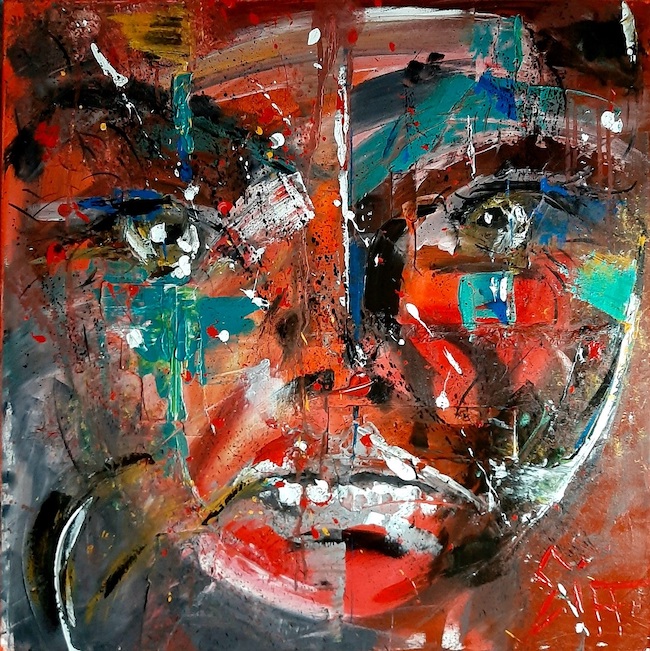Il ritratto ha costituito un punto fermo essenziale nella pittura di ogni tempo, aderendo secolo dopo secolo alle linee guida dei vari movimenti artistici che si sono susseguiti, a volte evolvendosi, altre tornando verso il passato; la natura umana, le sue pulsioni, gli sguardi, i sorrisi, i pensieri celati dietro un’espressione enigmatica, affascinano da sempre artisti di ogni epoca e l’evoluzione di questo particolare genere pittorico non poteva non trovare uno spazio tutto suo anche nella contemporaneità con tutte le difficoltà che il vivere moderno porta con sé. Il protagonista di oggi sceglie proprio il ritratto per farne il suo tratto artistico distintivo, quello attraverso cui la sua sensibilità può dare libero sfogo all’interpretazione del mondo che gli ruota intorno.
Il ritratto ebbe la sua massima affermazione con il consolidarsi della nuova classe borghese per cui era una vera e propria moda farsi immortalare insieme ai propri cari commissionando agli artisti preferiti immagini che sarebbero sopravvissute al tempo; dunque avere all’interno delle dimore un pezzo d’arte non era più prerogativa esclusiva dei nobili bensì stava diventando possibile grazie ai mercanti, alle nuove miniere e industrie che sorgevano e a un nuovo benessere che accorciava le distanze sociali. Durante tutto il corso dell’Ottocento furono molti gli stili che si avvicendarono e che segnarono un’evoluzione stilistica che condusse poi alle avanguardie del Novecento; il Realismo era orientato a evidenziare e raccontare la realtà in maniera oggettiva, senza dunque che l’esecutore dell’opera imprimesse sulla tela la propria soggettività, il proprio sentire. Il ritratto doveva essere il più fedele possibile a ciò che lo sguardo coglieva, senza interpretare o dare un punto di vista bensì semplicemente riproducendo dettagli e tratti della persona protagonista. Poco dopo fu l’Impressionismo a dare un nuovo volto al ritratto, così come d’altronde a tutta la realtà osservata, in virtù dell’irradiante luce ottenuta dalle sfaccettature delle pennellate attraverso cui, ancora una volta, ciò che doveva emergere era l’armonia estetica, la piacevolezza del vivere, tutto il bello che circondava l’esistenza di quella parte di società. Tra i maestri del ritratto impressionista vi fu l’italiano Giovanni Boldini, talmente abile nel mettere in evidenza la perfezione delle forme attraverso il sapiente uso del colore da essere il più richiesto ritrattista della nobiltà europea; le pose in cui immortalava i suoi soggetti contribuivano a infondere nell’osservatore un senso di ammirazione e di fascinazione che però, anche in questo caso, difficilmente si spingeva in profondità, verso le sensazioni e le emozioni del soggetto. Fu l’Espressionismo a effettuare quel percorso introspettivo necessario a lasciar fuoriuscire con forza e impellenza tutto il mondo emotivo che nei movimenti antecedenti era stato soffocato, nascosto e considerato irrilevante per un’opera d’arte sulla base di linee guida che andavano verso una direzione opposta; a seguito invece della rivoluzione stilistica e cromatica prefigurata dai Fauves e poi arricchita e consolidata dagli espressionisti, la connessione tra forma esterna e sentire interiore cominciò a emergere in modo netto, sovvertendo ogni regola accademica, perché una tela doveva parlare un linguaggio diverso che fosse capace di allinearsi a quelle tempeste emotive appartenenti all’essere umano attraverso l’uso irrazionale e anarchico del colore. Il bolognese Giorgio Sannino mostra una forte capacità espressiva attraverso ritratti indefiniti in cui ciò che conta non è il volto della persona protagonista bensì le sue sensazioni, quel mare in tempesta in grado di fuoriuscire dal filtro della razionalità, dall’apparente equilibrio manifestandosi sulla tela sotto forma di frammenti cromatici in perfetto accordo con il percepito dal soggetto.
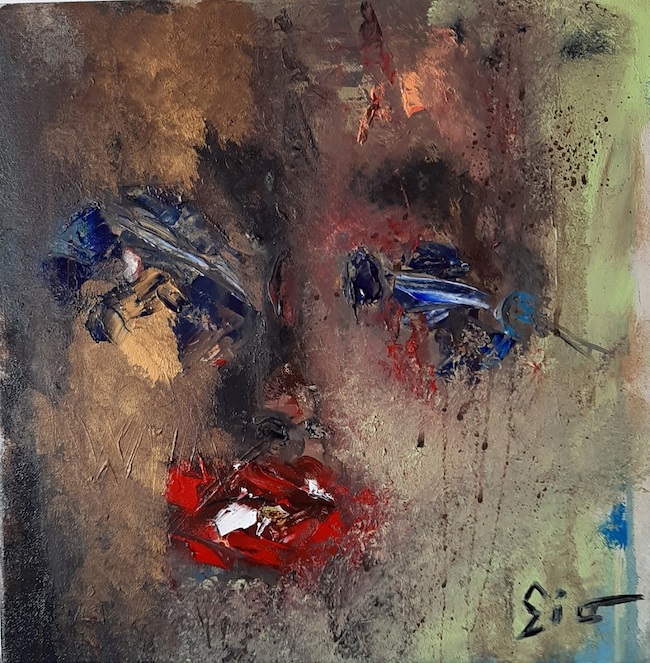
La figurazione si perde all’interno di una lieve astrazione, come se per l’artista fosse necessario andare oltre i confini del visibile per scendere in profondità, sfumare i contorni per lasciar emergere tutto ciò che diversamente non si noterebbe, restando celato dalla maschera indossata per presentarsi al mondo; a volte lo sguardo predomina sul resto del ritratto, come se fosse l’unico dettaglio necessario a cercare l’empatia con l’osservatore, per comunicargli l’inespresso, quel sottile flusso energetico che si libera solo attraverso un attento ascolto.
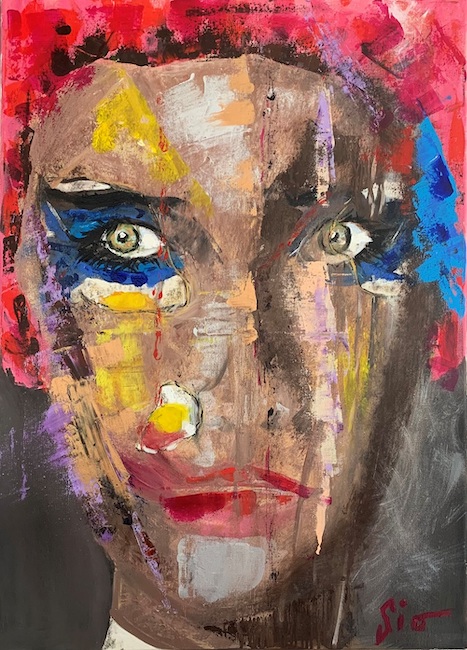
Ed è proprio su questo tipo di connessione che si concretizza la capacità espressiva di Giorgio Sannino, quell’andare a ricercare la nota del silenzio, lui che da musicista conosce bene la rilevanza dell’accordo o la sua dissonanza in grado di modificare un’intera melodia musicale quanto esistenziale; utilizzando i colori come se fossero note su un pentagramma riesce a generare un vortice di piccole emozioni che, osservate nella loro globalità raccontano una situazione vissuta, un modo di essere, un approccio alla vita o, più semplicemente uno stato d’animo legato a una ben precisa situazione.
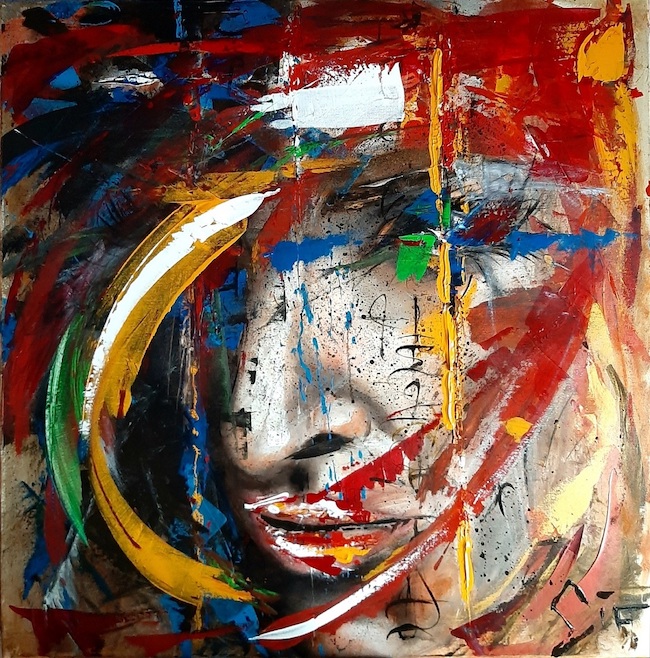
Nella tela Cecità n. 2 l’artista affronta un tema attuale e tipico della natura dell’uomo contemporaneo, quello cioè del trascurare di osservare tutto ciò che accade intorno a sé prediligendo un individualismo, una mancanza di attenzione verso quanto non rientri negli obiettivi, nelle finalità prioritarie dell’ego, del correre verso scopi materialistici; l’uomo descritto da Sannino appare distratto dalle pennellate colorate, come se indossasse un’armatura lucente dalla quale si sente inattaccabile dalle debolezze che vede intorno, insensibile alla sofferenza e al dolore appartenente agli altri, vicini eppure tenuti a distanza proprio dalla sua tendenza a non voler compartecipare, a non voler guardare.
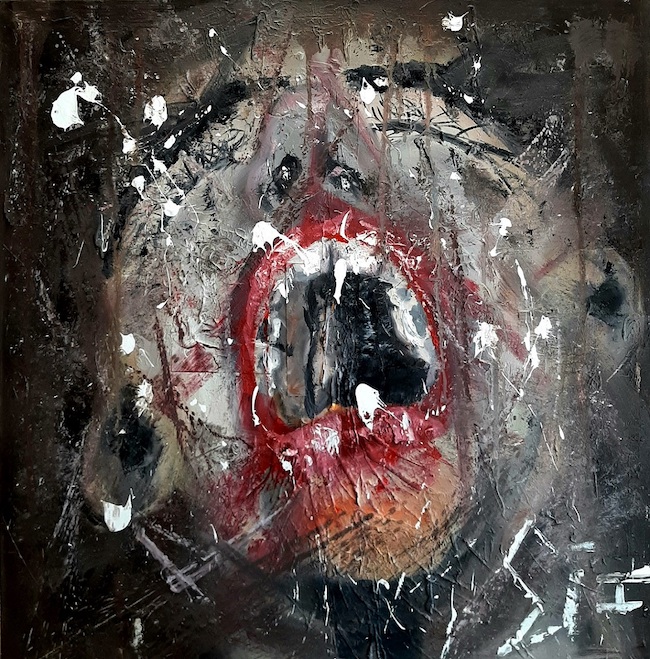
Dal distacco della cecità l’artista passa a raccontare quelle grida silenziose, quelle di chi, al contrario del soggetto precedente, sembra assorbire il dolore del mondo, come di se stesso, sentendo il bisogno di uscire da una condizione intrappolante per trovare nuova linfa, una speranza; l’opera Aria parla di questo, della disperazione di un individuo incapace di trovare un gancio, di rialzarsi per andare verso una soluzione a un problema che lo tiene immobile e dunque l’unica cosa che riesce a compiere è quel grido che giunge all’osservatore con tutto l’impatto emotivo e la forza della disperazione osservabile dal suo volto.
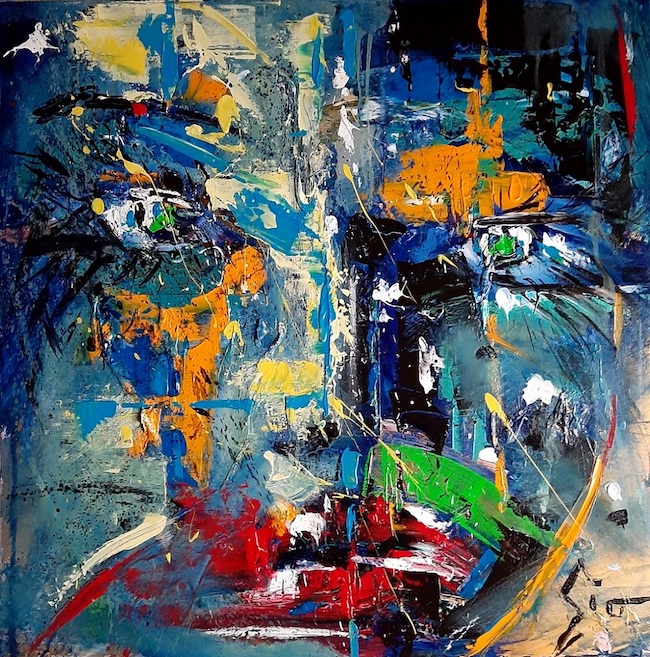
In Buio n. 2 l’attenzione va contro un immaginario comune che lega l’oscurità al colore nero perché per Giorgio Sannino la notte, metafora anche di una fase o un momento difficile, può essere attraversata da mille cromatismi, da mille tonalità in grado di modificare l’assetto di un percorso apparentemente difficile eppure possibilmente sereno, se si ha la capacità di volgere al positivo le esperienze che si attraversano; l’attitudine a vedere la luce in un periodo cupo permette all’essere umano di vivere gli accadimenti come una fase di passaggio tra un prima e un dopo, senza soffermarsi sulla sofferenza e sul dolore bensì aggrappandosi alla forza di reagire e di ricominciare, guardando già il momento successivo che sta per sopraggiungere anziché crogiolarsi tristemente su un presente che non rende appagati. La protagonista, apparentemente triste, immagina già il dopo, quel ventaglio di colori e di possibilità che aspettano dietro l’angolo di essere riscoperti.
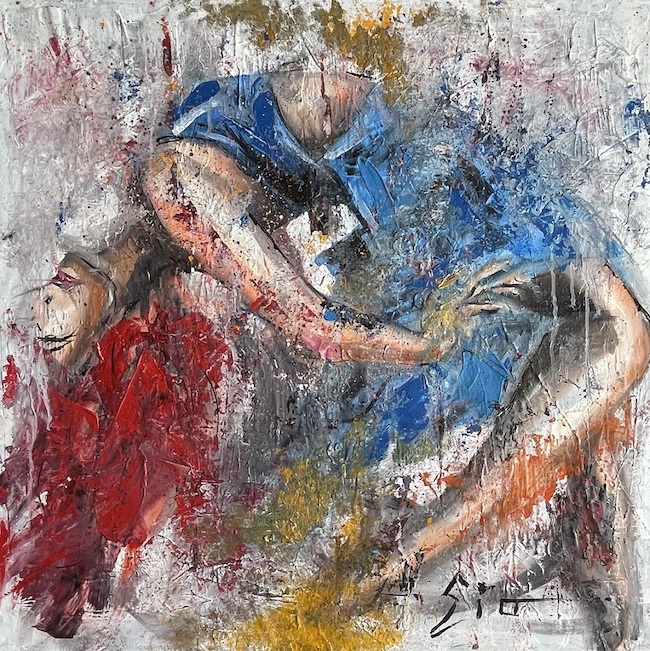
Nell’opera Era come volare, Sannino abbandona il ritratto del volto e passa alla rappresentazione più estesa, quella di un corpo femminile sospeso attraverso cui riesce a esprimere il momento introspettivo del sogno, del ricordo quasi inconscio, o forse sarebbe meglio dire trattenuto in un angolo della memoria che non è in grado di impedirgli di raggiungere e avvolgere l’emotività, in virtù del quale la protagonista si lascia andare, inerme e completamente abbandonata, come se dopo aver combattuto per dimenticare la sua interiorità avesse deciso di cedere e lasciarsi cullare da una memoria lontana ma ancora intensa. Il rosso della passione, l’azzurro del sogno, il giallo della gioia emergono e prevalgono sull’immagine sottintesa del corpo della donna perché in quel frangente, come d’altronde in tutta la produzione artistica di Sannino, la fisicità e la definizione dell’aspetto esteriore non sono rilevanti anzi, sarebbero un ostacolo al flusso emozionale.
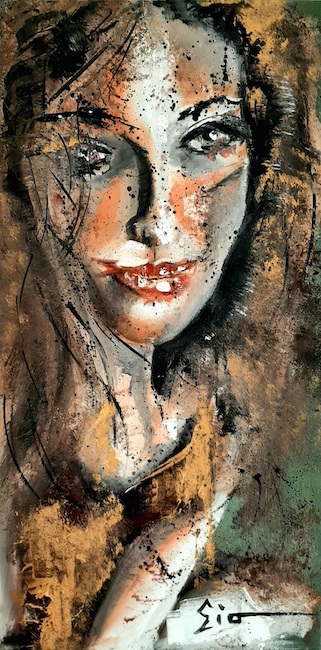
Nipote del grande pittore e scultore Ettore Sannino, Giorgio comincia a dipingere nel 2020, durante la pandemia, e nell’arco di due anni riscuote grandi successi: le sue opere sono state pubblicate in riviste del settore, ha collezionisti in tutta Italia e ha esposto in mostre collettive di rilevanza nazionale mentre a marzo è in programma una sua mostra personale a Viterbo.
GIORGIO SANNINO-CONTATTI
Email: giosannino68@gmail.com
Sito web: www.giorgiosanninopainter.com
Facebook: https://www.facebook.com/giorgio.sannino.547
Instagram: https://www.instagram.com/giosaniofifty/
Giorgio Sannino’s undefined portraits, lost between overwhelming emotions and existential fragility
The portrait has been an essential fixed point in the painting of all times, adhering century after century to the guidelines of the various artistic movements that have followed one another, at times evolving, at others returning to the past; human nature, its impulses, glances, smiles, thoughts hidden behind an enigmatic expression, have always fascinated artists of all ages and the evolution of this particular pictorial genre could not fail to find a space of its own even in the contemporary world with all the difficulties that modern life brings with it. Today’s protagonist chooses the portrait as his distinctive artistic trait, the one through which his sensitivity can give free rein to his interpretation of the world around him.
Portraiture was at its height with the consolidation of the new bourgeois class, for whom it was the fashion to have themselves immortalised with their loved ones, commissioning their favourite artists to produce images that would survive the passage of time; so having a piece of artwork in the home was no longer the exclusive prerogative of the nobility, but was becoming possible thanks to merchants, the new mines and industries that were springing up and a new prosperity that shortened social distances. Throughout the nineteenth century, many styles followed one another and marked a stylistic evolution that led to the avant-garde movements of the twentieth century; Realism was oriented towards highlighting and recounting reality in an objective manner, without the artist imprinting his own subjectivity and feelings on the canvas. The portrait had to be as faithful as possible to what the eye could see, without interpreting or giving a point of view, but simply reproducing details and features of the protagonist. Shortly afterwards it was Impressionism that gave a new face to the portrait, as well as to all observed reality, by virtue of the radiant light obtained from the facets of the brushstrokes through which, once again, what had to emerge was aesthetic harmony, the pleasantness of living, all the beauty that surrounded the existence of that part of society.
Among the masters of Impressionist portraiture was the Italian Giovanni Boldini, who was so skillful at highlighting the perfection of form through the clever use of colour that he was the most sought-after portrait painter of the European nobility; the poses in which he immortalised his subjects helped to instil in the viewer a sense of admiration and fascination that, even in this case, hardly went deep into the feelings and emotions of the subject. It was Expressionism that made the introspective journey necessary to forcefully and urgently let out the whole emotional world that in the previous movements had been stifled, hidden and considered irrelevant for an artwork on the basis of guidelines that went in the opposite direction; however, following the stylistic and chromatic revolution foreshadowed by the Fauves and then enriched and consolidated by the Expressionists, the connection between external form and inner feeling began to emerge clearly, subverting all academic rules, because a canvas had to speak a different language that was capable of aligning itself with those emotional storms belonging to the human being through the irrational and anarchic use of colour. The Bolognese artist Giorgio Sannino shows a strong expressive capacity through undefined portraits in which what counts is not the face of the protagonist but his feelings, that stormy sea able to escape from the filter of rationality, from the apparent balance manifesting itself on the canvas in the form of chromatic fragments in perfect agreement with the subject’s perception. Figuration is lost within a slight abstraction, as if it were necessary for the artist to go beyond the boundaries of the visible to descend into the depths, blurring the contours to allow emerging everything that otherwise would not be noticed, remaining concealed by the mask worn to present itself to the world; at times the gaze predominates over the rest of the portrait, as if it were the only detail necessary to seek empathy with the observer, to communicate the unexpressed, that subtle flow of energy that is only released through careful listening.
And it is precisely on this type of connection that Giorgio Sannino’s expressive capacity takes shape, that of going in search of the note of silence, he who, as a musician, knows well the relevance of the chord or its dissonance capable of modifying an entire musical melody as much as an existential one; using colours as if they were notes on a pentagram, he manages to generate a vortex of small emotions which, observed in their global nature, tell of a situation experienced, a way of being, an approach to life or, more simply, a state of mind linked to a specific situation. In the canvas Cecità n. 2 (Blindness no. 2) the artist tackles a current theme typical of the nature of contemporary man, that of neglecting to observe everything that happens around him, preferring an individualism, a lack of attention to anything that is not part of the objectives, the priority aims of the ego, of running towards materialistic goals; the man described by Sannino appears distracted by the coloured brushstrokes, as if he were wearing a shining armour from which he feels unassailable by the weaknesses he sees around him, insensitive to the suffering and pain of others, close by but kept at a distance precisely because of his tendency not to want to participate, not to want to look. From the detachment of blindness, the artist moves on to recount those silent cries, that of someone who, unlike the previous subject, seems to absorb the pain of the world, as well as of himself, feeling the need to escape from a trapping condition to find new lifeblood, a hope; the painting Aria (Air) speaks of this, of the desperation of an individual who is unable to find a hook, to get up and move towards a solution to a problem that keeps him immobile, and therefore the only thing he manages to do is that cry that reaches the observer with all the emotional impact and strength of the desperation observable on his face.
In Buio n. 2 (Darkness no. 2) the attention goes against a common imagery that links darkness to the colour black, because for Giorgio Sannino the night, a metaphor also of a difficult phase or moment, can be crossed by a thousand colours, a thousand shades capable of modifying the order of an apparently difficult yet possibly serene path, if one has the ability to turn the experiences one goes through into a positive one; the ability to see the light in a dark period allows the human being to live events as a phase of passage between a before and an after, without dwelling on the suffering and pain but clinging to the strength to react and start again, already looking at the next moment that is coming instead of wallowing sadly in a present that does not make us satisfied. The protagonist, apparently sad, is already imagining the next moment, that range of colours and possibilities waiting around the corner to be rediscovered. In Era come volare (It was like flying), Sannino abandons the portrait of the face and moves on to a more extensive representation, that of a suspended female body through which she succeeds in expressing the introspective moment of the dream, of the almost unconscious memory, or perhaps it would be better to say held in a corner of the memory that is unable to prevent it from reaching and enveloping emotionality, by virtue of which the protagonist lets herself go, defenceless and completely abandoned, as if after having fought to forget her interiority she had decided to give in and let herself be rocked by a distant but still intense memory. The red of passion, the blue of dreams and the yellow of joy emerge and prevail over the implied image of the woman’s body because in this case, as in all Sannino’s artistic production, physicality and the definition of the external appearance are not important; on the contrary, they would be an obstacle to the emotional flow. Grandson of the great painter and sculptor Ettore Sannino, Giorgio began painting in 2020, during the pandemic, and within two years had great success: his artworks have been published in magazines, he has collectors all over Italy and he has exhibited in collective exhibitions of national importance, while in March he is scheduled to hold a personal exhibition in Viterbo.


